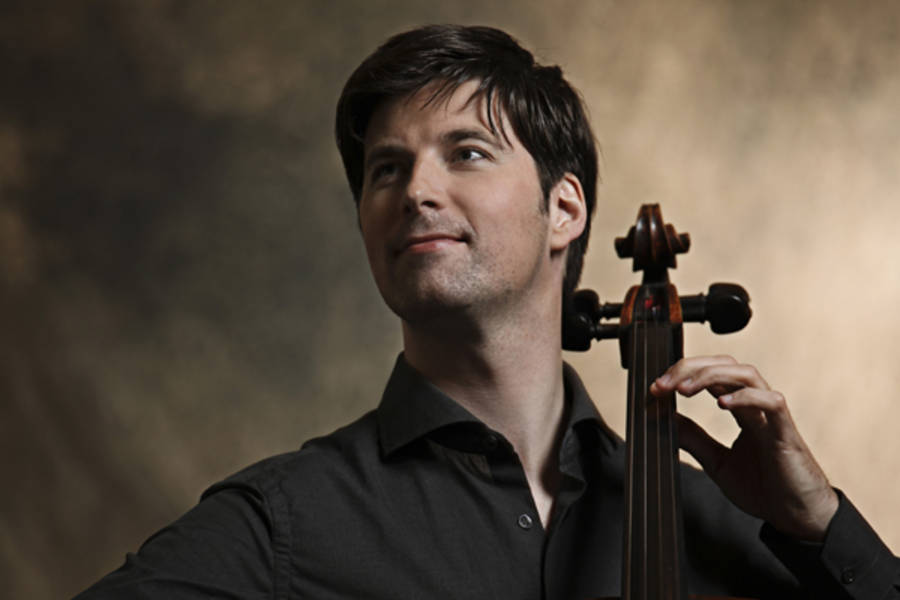TONAL BEAUTY FROM MULLER-SCHOTT AND TRPCESKI
Daniel Muller-Schott, cello; Simon Trpceski, piano, Cello Sonatas of Beethoven, Brahms and Chopin, Playhouse, April 22, 2014.
Daniel Muller-Schott
There are few more distinguished young soloists around these days than cellist Daniel Müller-Schott and pianist Simon Trpčeski, and it is cause for celebration that they have come together for an international tour this year. Chamber music ventures indeed seem to becoming more frequent for both artists: they are fresh off a very well-received Wigmore Hall collaboration with violinist Julia Fischer last month. We have seen each artist on their own in a number of very enjoyable concerts in the past, and the Vancouver Recital Society in fact has sponsored the cellist from his very early days. The feature that seemingly unites both Müller-Schott and Trpceski is the remarkable tonal beauty and strong romantic sentiment in their playing, the basis for a really exciting match. Certainly, what we saw from Müller-Schott at this concert was close to stunning: it is remarkable how much his technical sophistication and control has advanced in a relatively few years, and just how warm and ravishing much of his tonal output is. There is much feeling but also tremendous refinement, shape and eloquence too. Simon Trpčeski has always had a strong structural awareness and dramatic sense, but is equally able to find a feathery lightness in articulation and a subtle range of tone colour.
The often-neglected Cello Sonata of Chopin was the highlight of the evening, given a wonderfully romantic, expressive treatment that I think raised its stature as a composition. The artists achieved just the right enthusiasm and natural flow from its outset, capturing all its emotional shades, from its poetic tender musings to its passionate headlong outbursts. The following Scherzo had a remarkable range of tone colours and Müller-Schott’s silken-smooth delivery of the lovely waltz theme in the trio was most affecting. The following Largo built on this, with more silken beauty and soft, tender legato lines, a genuine glow coming from the collaboration. The finale carried the work home with the right type of robust expressive power. One nice thing about this sonata is that it allows an important soloistic contribution from the piano, and here Trpčeski did not disappoint, bringing a keen awareness of Chopin style..
Simon Trpceski
There was also lovely shaping and ardour in the striding theme that opens the Brahms Cello Sonata No. 2. Müller-Schott brought a full arsenal of slides and vibrato to convey a wistful melancholy as the opening movement progressed, coming together with the pianist to produce genuinely volcanic outbursts at dramatic points. Here there was much beauty again but I did sense a less natural flow in the articulation, and less subliminal understanding between the artists. Sometimes I thought that the cellist was slightly over-sophisticated in bringing out different textural hues and shaping, sacrificing some line and sinew in the process. The following Adagio achieved a touching intimacy nonetheless, and the trio of the following movement was very engaging. In the finale and at points earlier on, some lack of coordination could be perceived. When Müller-Schott’s natural tendency is to slow down the music to facilitate expressive nuance and shading, it seems imperative that the pianist act as a very firm anchor for him in these circumstances. Yet I think Simon Trpčeski went off a bit on his own journey, sometimes adding a different type of volatility and texture to the music. Sometimes he may have been slightly too loud for the required balance, and his attempts to achieve a prettier -- almost Chopinesque -- lightness and colour, and to propel the last movement with a mercurial fervour, did seem slightly at odds with the cellist and perhaps with the firm decisiveness of Brahmsian expression.
The last two cello sonatas of Beethoven certainly are ‘late’ Beethoven and have all the quirkiness and elliptical features of works of this period. Op. 102, No. 1 combines a subtle inward musing with abrupt and fragmented slices of counterpoint, and it is always a challenge for the performers to balance expression with its tight structural demands. This performance seemed to aim for a richer romantic treatment too. The cello’s opening exploration was given strong gravitas, beautifully poignant -- but perhaps too much. The piano seemingly played a lesser role in what can be an egalitarian duet. In turn, when the piano had some room to work, I thought it was a bit too volatile and eager. The Adagio of the second movement added an additional variety of expressive hues and drama, finishing with a nicely cultivated Allegro. Not really the late Beethoven I am used to, but perhaps I am too enamoured with the tightly-argued ingenuity and structural economy of these pieces. Again, the playing was quite lovely, as it was in the Chopin and Shostakovich encores that followed the very enthusiastic ovation.
I was strongly taken with the beauty and artistry that I witnessed at this concert. While there is still room for these two artists to get really used to each other, they show wonderful potential overall. I think there is some self-consciousness in Daniel Müller-Schott’s desire to probe soft passages and inform them with gorgeous hues and shadings. But there is of course a trade-off in removing it: we may get a more faithful and fluent structural line but we lose some of the ravishing beauty. Luckily, the cellist is in good company. We used to raise the same concerns with both Jacqueline Du Pré and Yo-Yo Ma -- and look what they became!
© Geoffrey Newman 2014

